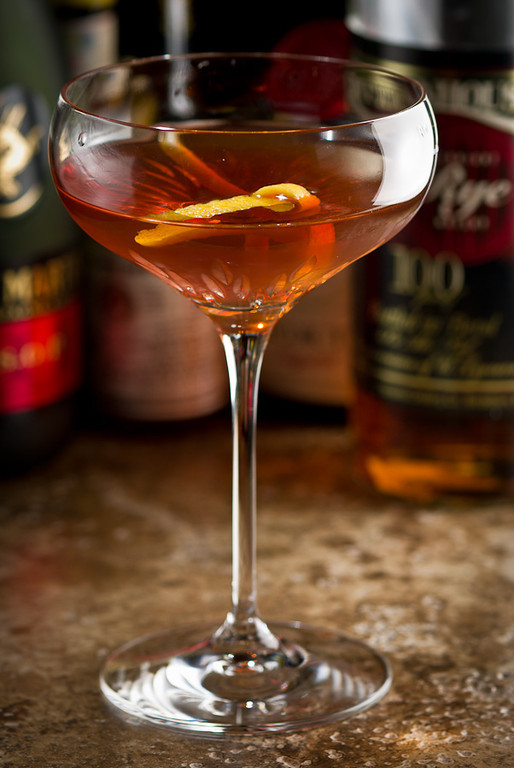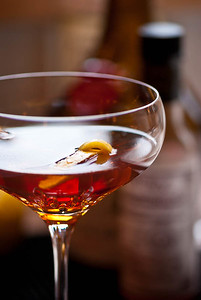The Vieux Carré is New Orleans’ contribution to the Manhattan family. More specifically, it is a Saratoga, sweetened with a splash of Bénédictine and the city’s historic Peychaud’s bitters.
The Vieux Carré was first mixed in the mid-1930s by Walter Bergeron at New Orleans’s Hotel Monteleone. It is certainly a celebration of New Orleans culture and heritage— “Vieux Carré” translates to “Old Square,” one of the early French terms for the area now known as the French Quarter. Rye whiskey, Cognac, Bénédictine, Peychaud’s bitters—the New Orleans heritage is well represented in the ingredient list.

Stanley Arthur first published Bergeron’s Vieux Carré in his 1937 Famous New Orleans Drinks and How to Mix Them. The recipe looks like this:
The Vieux Carré Cocktail
- 1 oz rye whiskey (Wild Turkey 101, Rittenhouse 100)
- 1 oz Cognac (Remy-Martin VSOP)
- 1 oz sweet vermouth (M&R Rosso, Dolin)
- 1 barspoon Bénédictine
- 2 dashes Peychaud’s bitters
- 2 dashes Angostura bitters
This cocktail partners well with higher-proof ryes like Wild Turkey 101 and Rittenhouse 100. The extra backbone in the whiskey stands up well to the large portions of brandy and vermouth.
The sweetness in the Vieux Carré comes primarily from the Bénédictine, so you don’t want to overdo that ingredient unless you’re in the mood for a noticeably sweet cocktail. (One barspoon is about a teaspoon, roughly an eighth of an ounce, or 3–4 ml.) The sweet vermouth contributes to the sweetness, too; the more austere vermouths like M&R are good choices to avoid over-sweetening. The trick is to enjoy what Paul Clarke has called its “rich and decadent” nature without tipping over into excessive sweetness.
 You’ll often see the Vieux Carré served in a rocks glass, in the old-school Sazerac style. I enjoy it in a stemmed glass, but it seems to taste fine either way.
You’ll often see the Vieux Carré served in a rocks glass, in the old-school Sazerac style. I enjoy it in a stemmed glass, but it seems to taste fine either way.
When I wrote up the Saratoga, I noted that the rye and brandy combination was a delicious revelation; this drink presents that same complex fruit-and-grain flavor theme, and adds the herbal complexities of the Bénédictine. There seems to be a fleeting orange note there, too; I don’t know if that’s coming from the Bénédictine or from the Peychaud’s.
 I am delighted to see the Vieux Carré making a comeback. Until a few years ago, the drink was lost and forgotten even at Hotel Monteleone; it’s encouraging to see that it has returned to the cocktail list at their famous Carousel Bar.
I am delighted to see the Vieux Carré making a comeback. Until a few years ago, the drink was lost and forgotten even at Hotel Monteleone; it’s encouraging to see that it has returned to the cocktail list at their famous Carousel Bar.
It remains to be seen if that comeback will stick, though—you’re still unlikely to encounter it on your local tavern’s cocktail list. Fortunately it is easy to make, and the Peychaud’s is the only ingredient that might not be readily available everywhere.
(One more thing: if you enjoy the Vieux Carré, you should be sure to try Cocktail La Louisiane.)
“Drinking the French Quarter: The Vieux Carré Cocktail” at cold-glass.com : All text and photos Copyright © 2012 Douglas M. Ford. All rights reserved.

My first introduction to the Vieux Carre used Dale DeGroff’s ratio of 2 barspoons of Benedictine with 3/4oz vermouth, rye, and cognac. I didn’t care for it, as the Benedictine seemed to overpower the drink. I gave this cocktail another shot using the proportions you listed here, and I loved it! Thanks for re-introducing me to this wonderful drink!
Vieux Carre is one of my favorites, I’m delighted to learn that you found your way back to it. Have you tried the Saratoga? It’s much the same drink, but without the Peychaud’s, and no Benedictine at all.
I’ve tried a scotch Saratoga some time back and remember liking it. I will definitely have to try it with a rye or bourbon to more closely parallel the Vieux Carre. Thanks for the suggestion!
Could you tell me the identity of the stemmed glass that is depicted in the accompanying photographs?